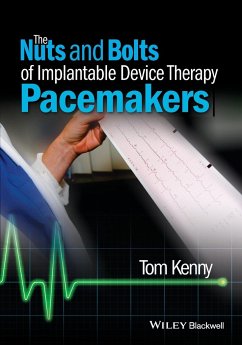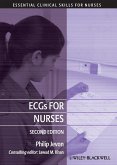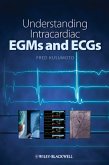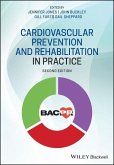Tom Kenny (FHRS, CCDS, Director of Education, PrepMD, Braintree, MA
The Nuts and Bolts of Implantable Device Therapy
Pacemakers
Tom Kenny (FHRS, CCDS, Director of Education, PrepMD, Braintree, MA
The Nuts and Bolts of Implantable Device Therapy
Pacemakers
- Broschiertes Buch
- Merkliste
- Auf die Merkliste
- Bewerten Bewerten
- Teilen
- Produkt teilen
- Produkterinnerung
- Produkterinnerung
This book provides an excellent introductory resource for those new to cardiac pacing and pacemakers.
Andere Kunden interessierten sich auch für
![The Nuts and Bolts of ICD Therapy The Nuts and Bolts of ICD Therapy]() Tom Kenny (St. Jude Medical, Austin, Texas)The Nuts and Bolts of ICD Therapy65,99 €
Tom Kenny (St. Jude Medical, Austin, Texas)The Nuts and Bolts of ICD Therapy65,99 €![Ecgs for Nurses Ecgs for Nurses]() Philip Jevon (Walsall Manor Hospital)Ecgs for Nurses45,99 €
Philip Jevon (Walsall Manor Hospital)Ecgs for Nurses45,99 €![Understanding Intracardiac EGMs and ECGs Understanding Intracardiac EGMs and ECGs]() Fred M. KusumotoUnderstanding Intracardiac EGMs and ECGs83,99 €
Fred M. KusumotoUnderstanding Intracardiac EGMs and ECGs83,99 €![The Cardiovascular System at a Glance The Cardiovascular System at a Glance]() Philip I. Aaronson (London King's College)The Cardiovascular System at a Glance45,99 €
Philip I. Aaronson (London King's College)The Cardiovascular System at a Glance45,99 €![The Nuts and Bolts of Proofs The Nuts and Bolts of Proofs]() Antonella Cupillari (Pennsylvan Associate Professor of MathematicsThe Nuts and Bolts of Proofs65,99 €
Antonella Cupillari (Pennsylvan Associate Professor of MathematicsThe Nuts and Bolts of Proofs65,99 €![The Nuts and Bolts of College Writing The Nuts and Bolts of College Writing]() Michael HarveyThe Nuts and Bolts of College Writing24,99 €
Michael HarveyThe Nuts and Bolts of College Writing24,99 €![Cardiovascular Prevention and Rehabilitation in Practice Cardiovascular Prevention and Rehabilitation in Practice]() Cardiovascular Prevention and Rehabilitation in Practice70,99 €
Cardiovascular Prevention and Rehabilitation in Practice70,99 €-
-
-
This book provides an excellent introductory resource for those new to cardiac pacing and pacemakers.
Produktdetails
- Produktdetails
- The Nuts and Bolts Series
- Verlag: John Wiley and Sons Ltd
- Seitenzahl: 336
- Erscheinungstermin: 2. Januar 2015
- Englisch
- Abmessung: 254mm x 178mm x 19mm
- Gewicht: 650g
- ISBN-13: 9781118670675
- ISBN-10: 1118670671
- Artikelnr.: 42054294
- Herstellerkennzeichnung
- Libri GmbH
- Europaallee 1
- 36244 Bad Hersfeld
- gpsr@libri.de
- The Nuts and Bolts Series
- Verlag: John Wiley and Sons Ltd
- Seitenzahl: 336
- Erscheinungstermin: 2. Januar 2015
- Englisch
- Abmessung: 254mm x 178mm x 19mm
- Gewicht: 650g
- ISBN-13: 9781118670675
- ISBN-10: 1118670671
- Artikelnr.: 42054294
- Herstellerkennzeichnung
- Libri GmbH
- Europaallee 1
- 36244 Bad Hersfeld
- gpsr@libri.de
Tom Kenny, FHRS, CCDS Tom Kenny has always been an educator. From his start as a Critical Care Educator for the North Broward Hospital District in Fort Lauderdale, Florida, to serving as Director of Education at PrepMD in Braintree, Massachusetts, Tom has focused on providing real-world, practical education for clinicians. Although he has served on faculty at Broward Community College and lectures for the Heart Rhythm Society and the Food and Drug Administration, Tom has always believed that it was imperative to educate the "front lines" of healthcare, the men and women clinicians across the country who treat patients day in and day out. He has served at Intermedics and St. Jude Medical in corporate medical device education, where he sought to make highly complicated therapies easily understood. In his tenure at both companies, he expanded training programs and developed educational materials. Finding that there was little in the way of pacemaker training for educated clinicians who just did not happen to know pacing, Tom brought his style of training to the classroom and now to book form. Tom is a native New Yorker who currently divides his time between Massachusetts and Texas. He has five children.
Preface vi
Acknowledgments vii
1 Cardiovascular anatomy and physiology 1
2 Cardiac conduction system 15
3 The cardiac cycle and hemodynamics 21
4 Heart disease 29
5 Cardiac medications related to cardiac rhythm management devices 37
6 The basics of ecg and rhythm interpretation 48
7 Arrhythmia analysis 58
8 Electricity 101 78
9 Pacing 101 84
10 Indications for pacing 104
11 Pacemaker implantation 116
12 Connecting the leads to the pulse generator 131
13 Pacemaker modes and codes 140
14 Single-chamber timing cycles 153
15 Introduction to dual-chamber timing cycles 169
16 Dual-chamber timing cycles: the atrial channel 179
17 Dual-chamber timing cycles: the ventricular channel 195
18 Paced ECG and EGM analysis 205
19 Upper-rate behavior 219
20 Advanced dual-chamber timing 233
21 Rate-responsive pacing 242
22 Special features 260
23 Automatic capture algorithms 278
24 Pacemaker follow-up 297
25 Follow-up and troubleshooting 310
Key answer 316
Index 320
Acknowledgments vii
1 Cardiovascular anatomy and physiology 1
2 Cardiac conduction system 15
3 The cardiac cycle and hemodynamics 21
4 Heart disease 29
5 Cardiac medications related to cardiac rhythm management devices 37
6 The basics of ecg and rhythm interpretation 48
7 Arrhythmia analysis 58
8 Electricity 101 78
9 Pacing 101 84
10 Indications for pacing 104
11 Pacemaker implantation 116
12 Connecting the leads to the pulse generator 131
13 Pacemaker modes and codes 140
14 Single-chamber timing cycles 153
15 Introduction to dual-chamber timing cycles 169
16 Dual-chamber timing cycles: the atrial channel 179
17 Dual-chamber timing cycles: the ventricular channel 195
18 Paced ECG and EGM analysis 205
19 Upper-rate behavior 219
20 Advanced dual-chamber timing 233
21 Rate-responsive pacing 242
22 Special features 260
23 Automatic capture algorithms 278
24 Pacemaker follow-up 297
25 Follow-up and troubleshooting 310
Key answer 316
Index 320
Preface vi
Acknowledgments vii
1 Cardiovascular anatomy and physiology 1
2 Cardiac conduction system 15
3 The cardiac cycle and hemodynamics 21
4 Heart disease 29
5 Cardiac medications related to cardiac rhythm management devices 37
6 The basics of ecg and rhythm interpretation 48
7 Arrhythmia analysis 58
8 Electricity 101 78
9 Pacing 101 84
10 Indications for pacing 104
11 Pacemaker implantation 116
12 Connecting the leads to the pulse generator 131
13 Pacemaker modes and codes 140
14 Single-chamber timing cycles 153
15 Introduction to dual-chamber timing cycles 169
16 Dual-chamber timing cycles: the atrial channel 179
17 Dual-chamber timing cycles: the ventricular channel 195
18 Paced ECG and EGM analysis 205
19 Upper-rate behavior 219
20 Advanced dual-chamber timing 233
21 Rate-responsive pacing 242
22 Special features 260
23 Automatic capture algorithms 278
24 Pacemaker follow-up 297
25 Follow-up and troubleshooting 310
Key answer 316
Index 320
Acknowledgments vii
1 Cardiovascular anatomy and physiology 1
2 Cardiac conduction system 15
3 The cardiac cycle and hemodynamics 21
4 Heart disease 29
5 Cardiac medications related to cardiac rhythm management devices 37
6 The basics of ecg and rhythm interpretation 48
7 Arrhythmia analysis 58
8 Electricity 101 78
9 Pacing 101 84
10 Indications for pacing 104
11 Pacemaker implantation 116
12 Connecting the leads to the pulse generator 131
13 Pacemaker modes and codes 140
14 Single-chamber timing cycles 153
15 Introduction to dual-chamber timing cycles 169
16 Dual-chamber timing cycles: the atrial channel 179
17 Dual-chamber timing cycles: the ventricular channel 195
18 Paced ECG and EGM analysis 205
19 Upper-rate behavior 219
20 Advanced dual-chamber timing 233
21 Rate-responsive pacing 242
22 Special features 260
23 Automatic capture algorithms 278
24 Pacemaker follow-up 297
25 Follow-up and troubleshooting 310
Key answer 316
Index 320








